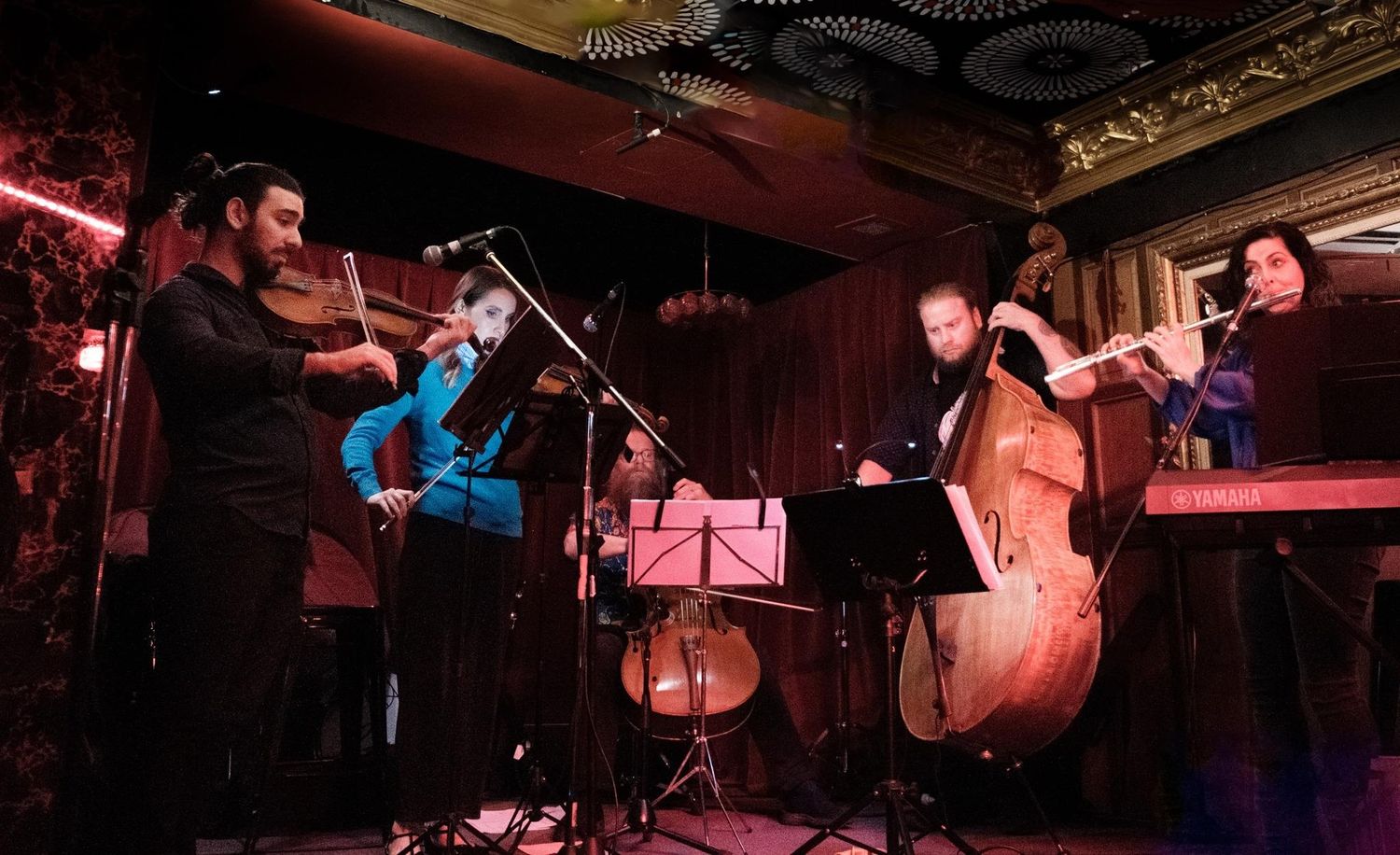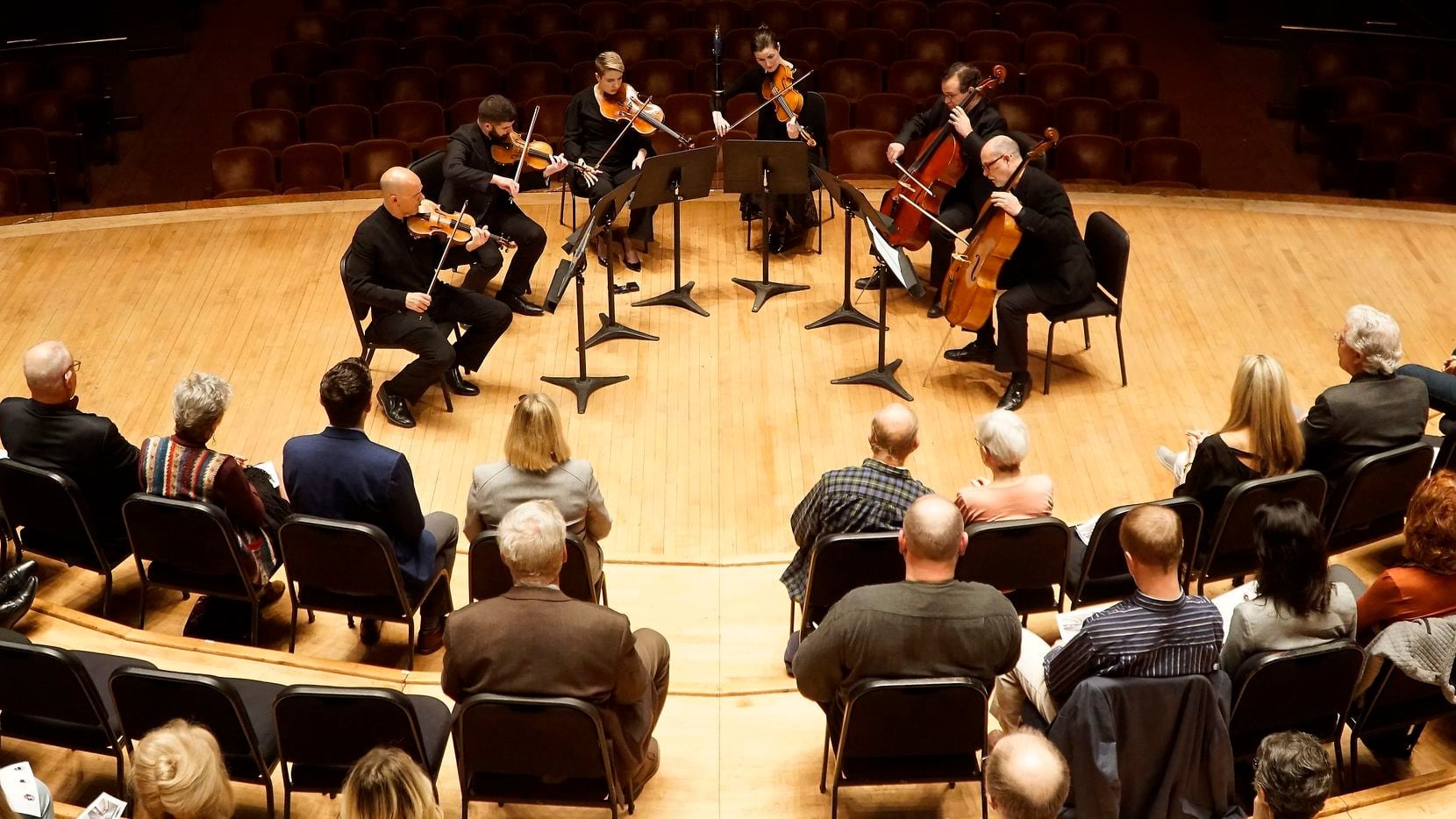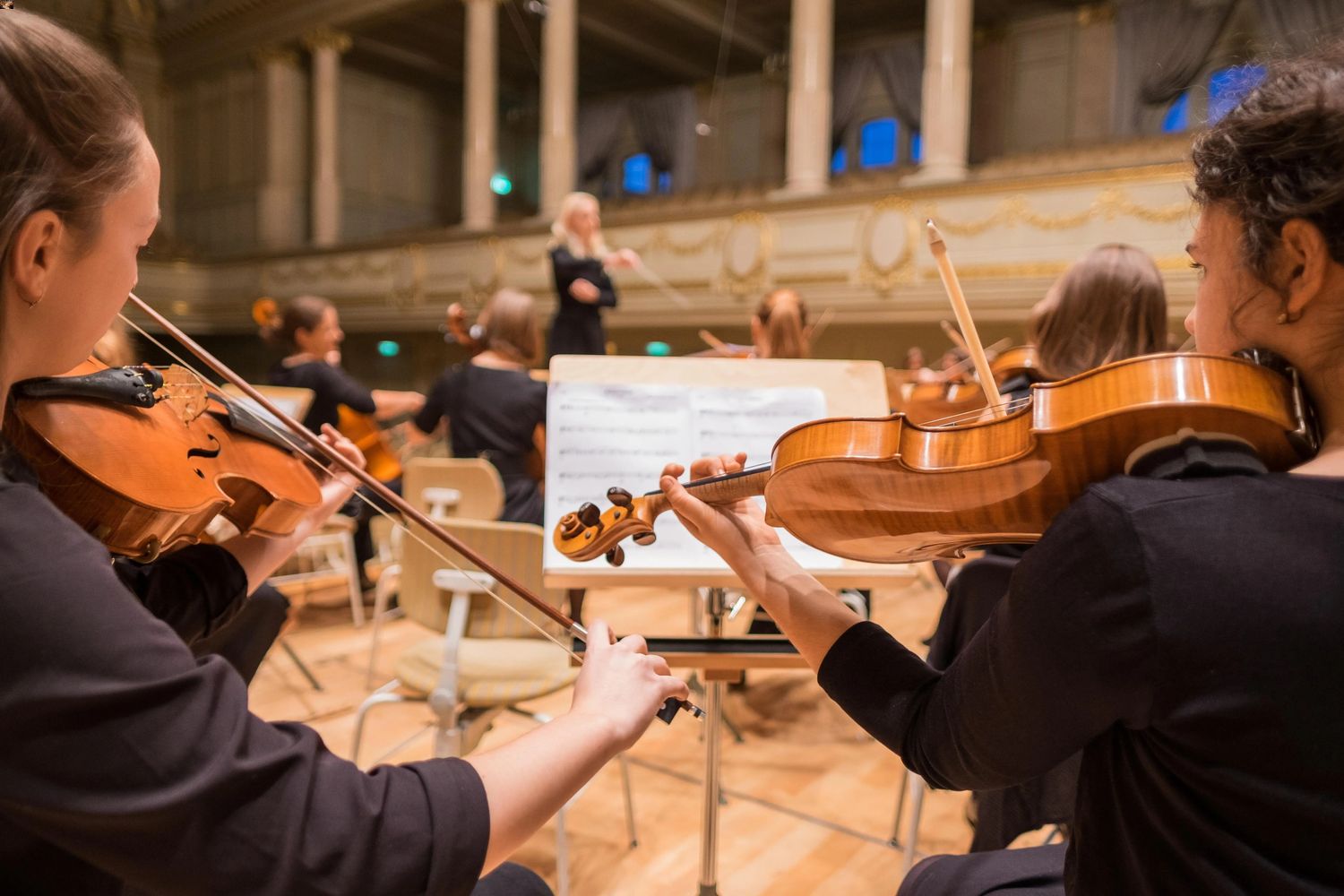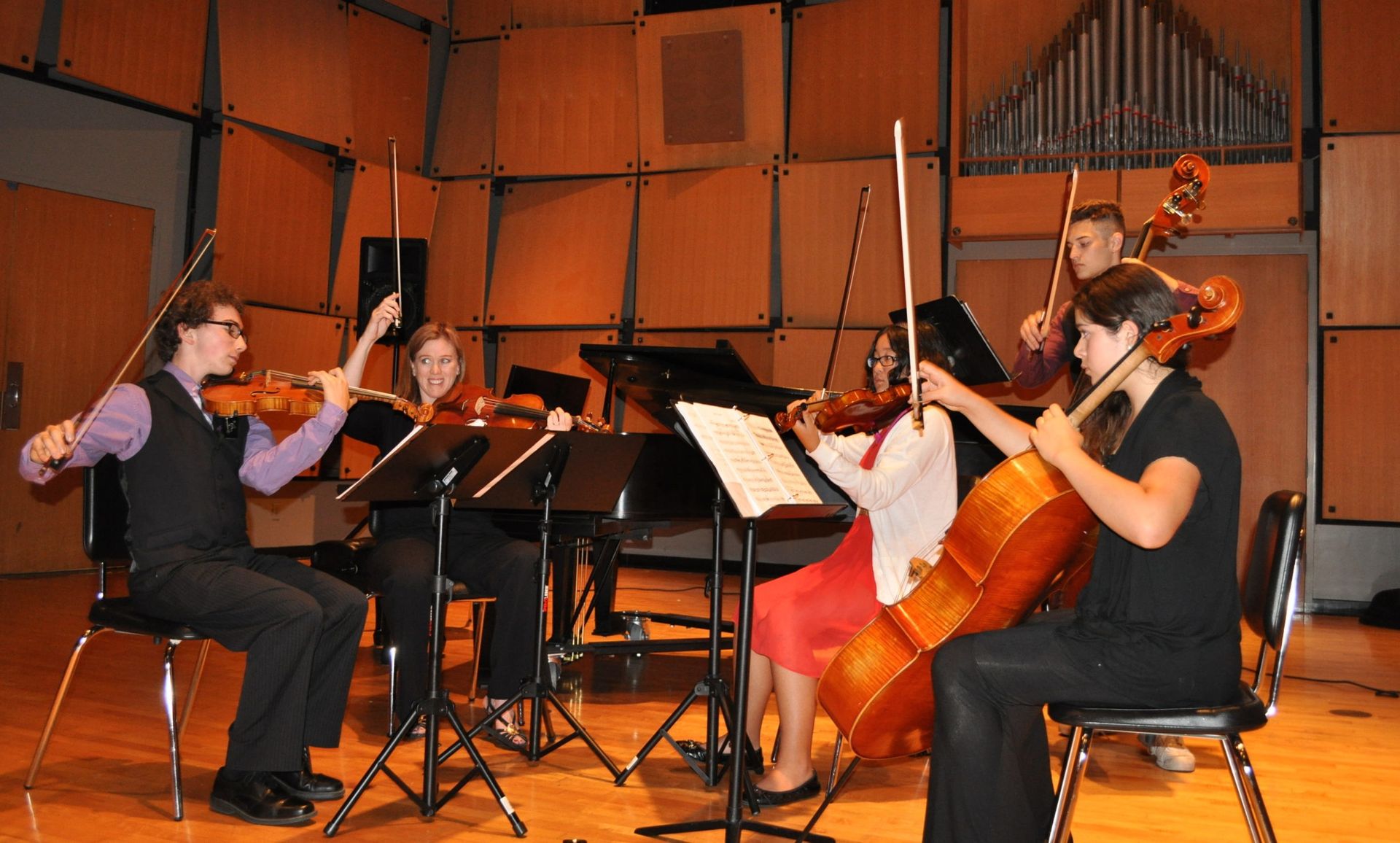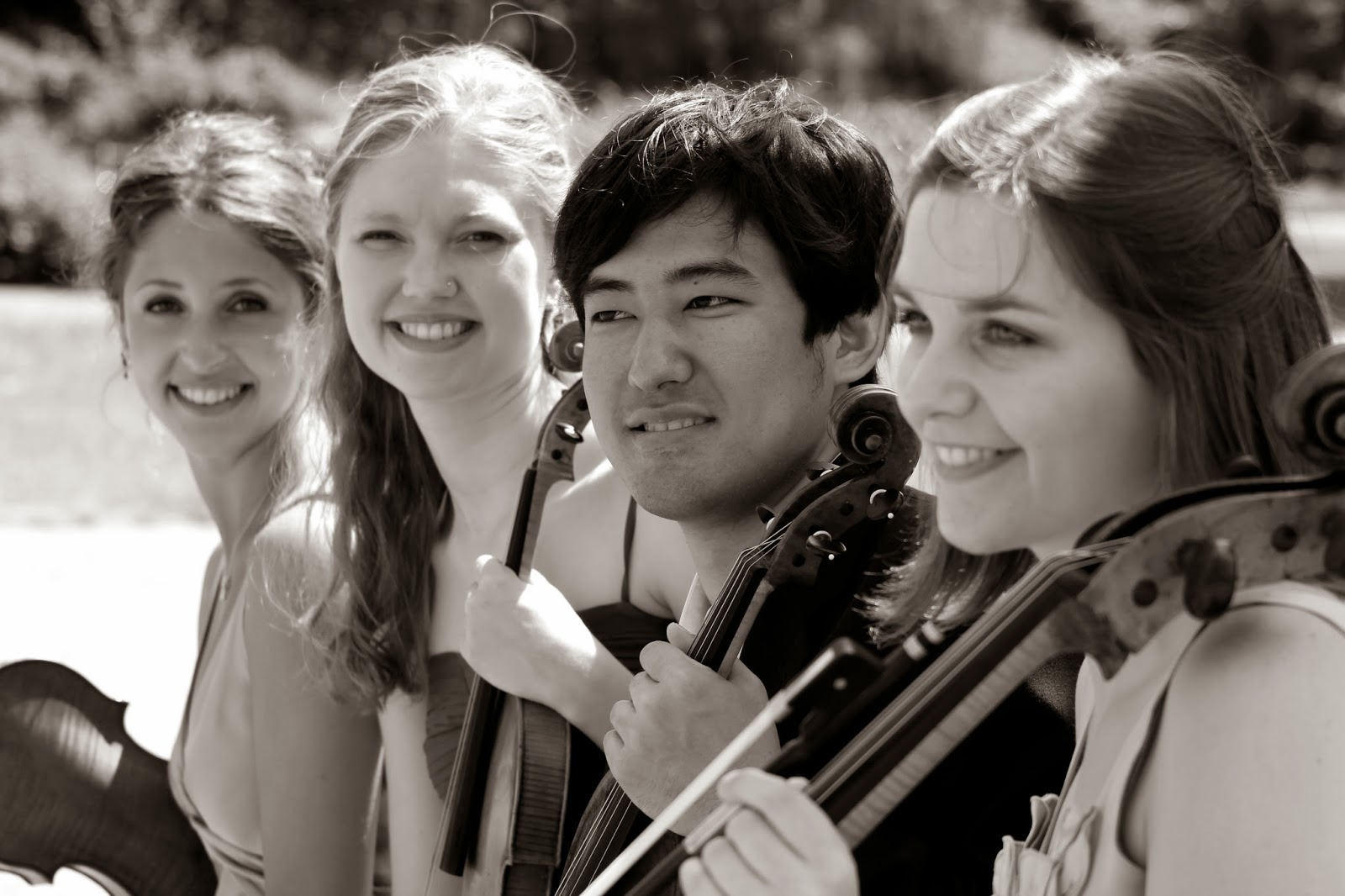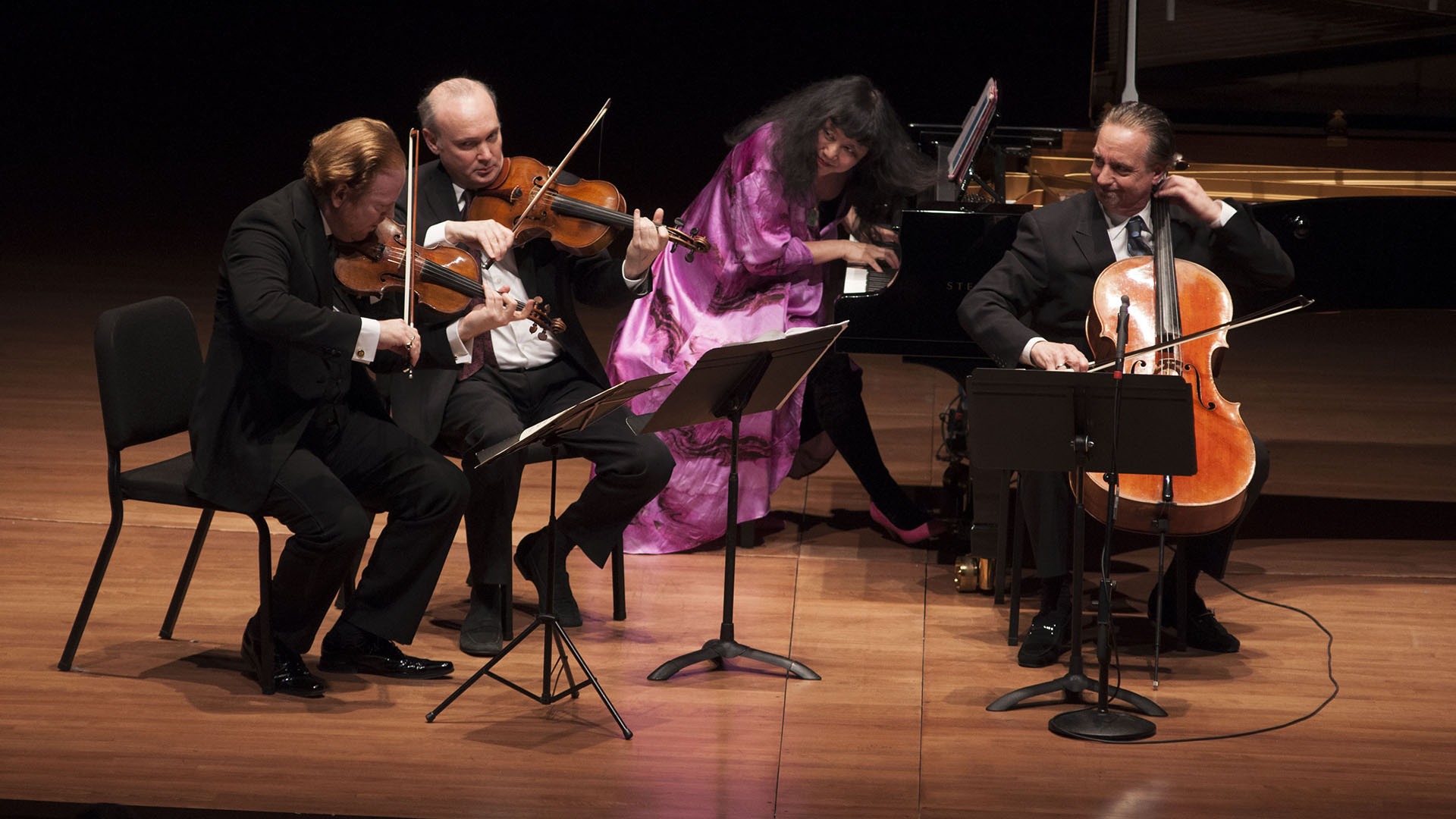Home>Events & Info>Chamber Music>How Does Orchestral Music Differ From Chamber Music
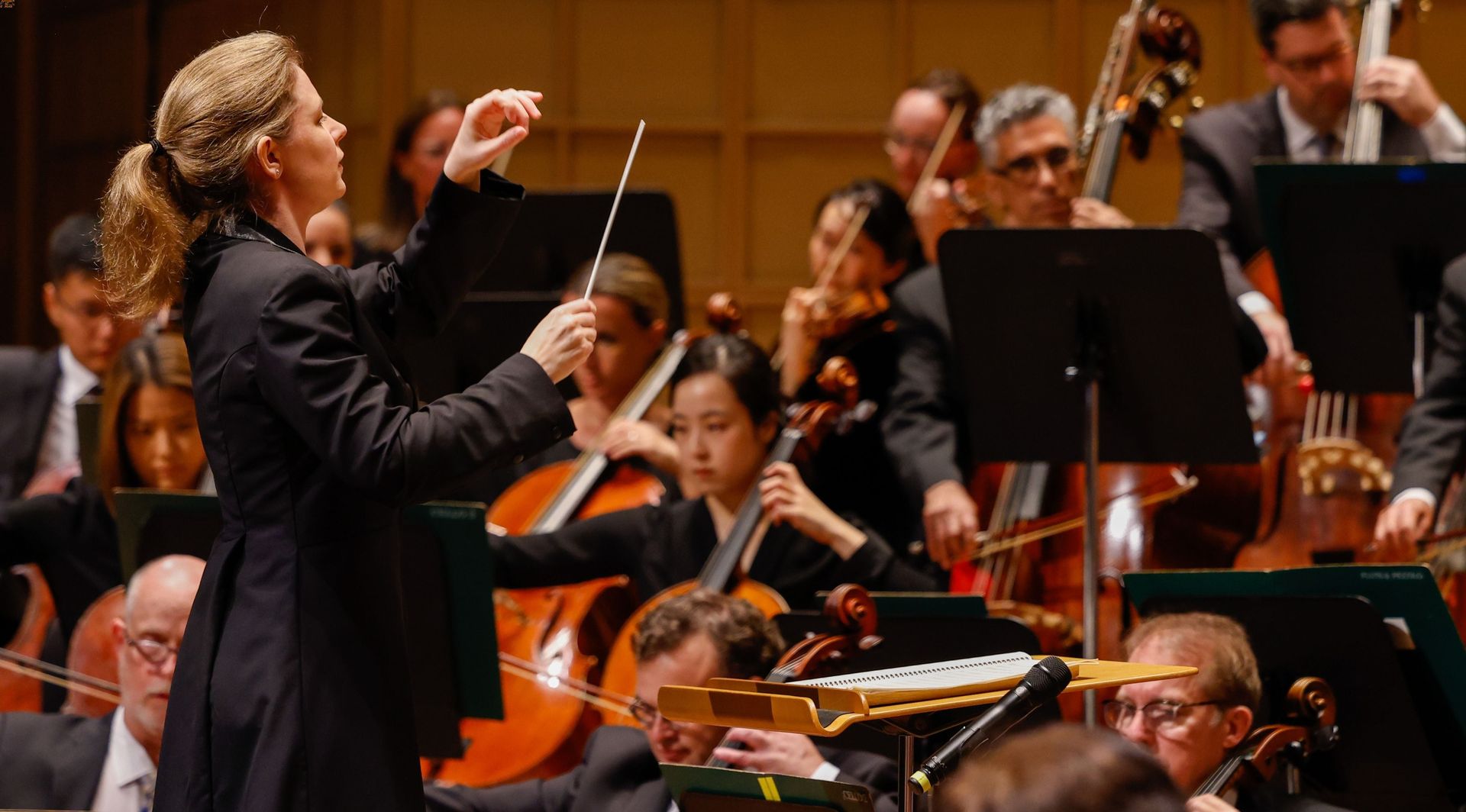

Chamber Music
How Does Orchestral Music Differ From Chamber Music
Modified: February 24, 2024
Discover the distinctions between orchestral music and chamber music. Delve into the unique characteristics and instrumentation of chamber music, a genre closely connected to the focus keyword, "Chamber Music."
(Many of the links in this article redirect to a specific reviewed product. Your purchase of these products through affiliate links helps to generate commission for AudioLover.com, at no extra cost. Learn more)
Table of Contents
- Introduction
- Definition of Orchestral Music
- Definition of Chamber Music
- Historical Background
- Composition and Instrumentation Differences
- Performance Differences
- Role of Conductor
- Collaborative Nature
- Venue and Audience Size
- Musical Complexity and Texture
- Communication and Interaction Among Musicians
- Conclusion
Introduction
Chamber music and orchestral music are two distinct genres that have captivated music lovers for centuries. While they both fall under the umbrella of classical music, they differ in various aspects, including composition, instrumentation, performance, and overall experience for both musicians and audiences.
In this article, we will explore the differences between orchestral music and chamber music, shedding light on their unique characteristics and the impact they have on the musical landscape.
Historically, chamber music refers to a genre of music that is performed by a small group of musicians in an intimate setting, such as a chamber or a small hall. On the other hand, orchestral music involves a larger ensemble of musicians, typically consisting of multiple sections of strings, woodwinds, brass, and percussion, guided by a conductor.
While both genres originated around the same time in the late 16th and early 17th centuries, their development and purpose diverged. Orchestral music, with its grandeur and larger-scale compositions, was often associated with court performances and public concerts, whereas chamber music was primarily performed in intimate settings for a more select audience.
Over time, both genres have evolved, embracing new styles and influences, but their defining characteristics have remained intact. Understanding the differences between orchestral music and chamber music can deepen our appreciation for each and allow us to explore the intricate beauty of classical music in its various forms.
Definition of Orchestral Music
Orchestral music is a genre of classical music characterized by the use of a large ensemble, known as an orchestra, comprised of various instrument families. The orchestra typically consists of strings, including violins, violas, cellos, and double basses, as well as woodwinds, brass, and percussion.
The composition of an orchestra can vary, but it often includes sections such as the strings, woodwinds (flutes, oboes, clarinets, bassoons), brass (trumpets, trombones, French horns), and percussion (drums, timpani, cymbals). Some orchestras may also feature additional instruments or sections, such as harps or choirs, depending on the specific composition being performed.
One defining characteristic of orchestral music is the role of a conductor. The conductor acts as the leader of the ensemble, guiding the musicians through the performance by providing cues, interpreting the music, and bringing out the desired dynamics and expression. The conductor’s role is crucial in ensuring that all the different sections and instruments blend together harmoniously.
Orchestral music is known for its expansive and captivating sound, which is achieved through the careful arrangement and interplay of different instruments and sections. Composers often utilize the full power and range of the orchestra to create dramatic, emotional, and grandiose compositions.
Orchestral music is typically performed in larger venues, such as concert halls or outdoor amphitheaters, to accommodate the size of the ensemble and to provide optimal sound projection. The audience for orchestral performances can range from a few hundred to several thousand people, depending on the venue and the popularity of the event.
As one of the most recognizable forms of classical music, orchestral compositions have a rich history and continue to inspire and captivate audiences around the world. From symphonies and concertos to overtures and tone poems, orchestral music offers a unique and immersive musical experience that showcases the beauty and complexity of the ensemble.
Definition of Chamber Music
Chamber music is a genre of classical music that is characterized by its intimate nature and small ensemble size. Unlike orchestral music, which features a large ensemble, chamber music is performed by a small group of musicians, typically ranging from two to nine performers.
The term “chamber” refers to a small room or chamber in which the music was historically performed. It often refers to music that was intended for private gatherings in aristocratic households or intimate settings, such as salons or small concert halls.
The most common ensemble formation in chamber music is the string quartet, consisting of two violins, a viola, and a cello. However, chamber music can also involve other instrument combinations, such as piano trios, wind ensembles, or mixed ensembles that include both string and wind instruments.
Chamber music is typically performed without a conductor, with each musician having a crucial role in interpreting and communicating the nuances of the composition. This collaborative approach fosters a close connection and interplay between the performers, resulting in intimate and intricate musical conversations.
The repertoire of chamber music includes a wide range of compositions, from classical works by composers such as Mozart, Haydn, and Beethoven, to contemporary pieces by living composers. It often showcases the virtuosity and technical skill of individual performers, while also highlighting the harmonious and balanced ensemble playing.
Unlike orchestral music, chamber music is often performed in smaller venues, such as chamber halls, art galleries, or even private residences, allowing for a more intimate and direct interaction between the performers and the audience. This closeness creates a unique and immersive experience, where the nuances of each instrument and the musicians’ expressions can be appreciated in detail.
Chamber music offers a more intimate and personal experience for both performers and audiences, allowing for a deeper connection to the music and a heightened appreciation of the musicians’ artistry. It embodies the essence of collaboration, as each musician contributes their unique voice to create a cohesive and harmonious musical dialogue.
Historical Background
The historical background of orchestral music and chamber music is intertwined, as both genres emerged during the Renaissance and Baroque periods in Europe. As musical tastes and societal circumstances evolved, they began to develop distinct identities.
Orchestral music can trace its roots back to the 17th century when royal courts and nobility sponsored large ensembles to perform grand and elaborate compositions. These ensembles, known as orchestras, grew in size over time and became associated with prestigious institutions and venues.
In contrast, chamber music was initially performed in more intimate settings, such as private chambers or salons, for a select group of aristocratic patrons. It provided a more personal and interactive experience, allowing for a direct connection between the musicians and the listeners.
During the Classical period in the late 18th and early 19th centuries, composers like Wolfgang Amadeus Mozart, Joseph Haydn, and Ludwig van Beethoven contributed significantly to the development of both orchestral and chamber music. Mozart composed symphonies and concertos for large orchestras, while also creating string quartets and other chamber music compositions.
The Romantic period brought further advancements in both genres. Orchestras grew in size, with composers like Gustav Mahler pushing the boundaries of orchestration and creating monumental symphonies. Chamber music also flourished during this time, with composers such as Franz Schubert and Johannes Brahms writing intricate and emotionally rich works for smaller ensembles.
With the advent of the 20th century, composers like Igor Stravinsky and Arnold Schoenberg challenged traditional musical conventions and expanded the possibilities of orchestral music. At the same time, chamber music continued to evolve, with composers like Béla Bartók and Dmitri Shostakovich experimenting with new forms and harmonies.
Today, both orchestral music and chamber music have a rich and diverse repertoire, encompassing works from various periods and styles. Orchestras perform symphonies, concertos, and symphonic poems, while chamber music ensembles interpret string quartets, piano trios, and wind quintets, among others.
The historical background of orchestral music and chamber music showcases their evolution from their shared roots to their distinct forms. Understanding their historical context allows us to appreciate the unique qualities and contributions of each genre, as well as their enduring relevance in the world of classical music.
Composition and Instrumentation Differences
One of the key differences between orchestral music and chamber music lies in their composition and instrumentation.
In orchestral music, the compositions are often larger in scale and complexity. Symphonies, concertos, and tone poems are common forms in orchestral repertoire. These compositions involve a wide range of instruments from different families, including strings, woodwinds, brass, and percussion. The size of the orchestra allows for a rich and varied sonic palette, with multiple orchestral sections coming together to create powerful and expansive musical works.
On the other hand, chamber music compositions are typically more intimate and refined. String quartets, piano trios, and wind ensembles are popular forms of chamber music. These compositions are designed for smaller groups of musicians, allowing for intricate interplay and close collaboration among the performers. Chamber music often emphasizes the individual voices of the musicians, showcasing their technical skill and musical expression as they engage in a musical dialogue.
The instrumentation of orchestras and chamber ensembles also differs significantly. Orchestras consist of a large number of musicians, typically divided into sections. The string section forms the foundation of orchestral sound, with multiple players on each instrument. Woodwind, brass, and percussion sections add color and texture to the overall sound, with each instrument playing a specific role.
Chamber ensembles, on the other hand, have a more limited number of players, often consisting of one player per instrument or a small number of musicians from each instrument family. This allows for a more nuanced and transparent sound, with the individual timbres of the instruments more clearly audible.
Compositionally, orchestral music often includes more intricate and layered arrangements, with multiple melodic lines and harmonies weaving together. The larger ensemble size allows for a greater range of musical possibilities, with composers able to employ complex counterpoint, rich harmonies, and dynamic contrasts.
In contrast, chamber music compositions typically focus on the subtleties of melodic and harmonic interactions in smaller settings. Composers of chamber music often rely on the interplay between the instruments, prioritizing balance and clarity of musical lines. The textures tend to be more transparent, with opportunities for individual instrumental voices to shine.
The distinctive composition and instrumentation of orchestral and chamber music contribute to their unique sonic qualities and artistic expressions. Whether it’s the grandeur of a full symphony orchestra or the delicate interplay of a string quartet, both genres offer immersive musical experiences that showcase the breadth and depth of the classical music tradition.
Performance Differences
The performance of orchestral music and chamber music differs in several significant ways, including the role of the conductor, the level of collaboration among musicians, and the overall experience for both performers and the audience.
When it comes to orchestral music, a conductor plays a central role in guiding the ensemble. The conductor acts as the leader and interpreter of the music, shaping the overall performance by setting the tempo, cueing entrances, and shaping the dynamics and expression of the orchestra. The conductor’s role is crucial in maintaining cohesion and unity among the large number of musicians.
In contrast, chamber music is typically performed without a conductor. Instead, the performers rely on their musical skills and communication to synchronize their playing and interpret the music collectively. Each musician has a more active role in shaping the performance, listening and responding to one another, and making decisions together on matters of interpretation, dynamics, and pacing.
This level of collaboration is a unique aspect of chamber music that fosters a deeper connection between the musicians. They must engage in constant communication, attune their playing to one another, and navigate the intricate interplay of multiple voices. This results in an intimate and symbiotic relationship among the performers, creating a highly interactive and cohesive musical experience.
Furthermore, the performance venues for orchestral music and chamber music also differ. Orchestral performances typically take place in larger concert halls or outdoor venues, accommodating a sizeable audience. The grandeur of the setting matches the expansive sound and visual spectacle of the orchestra, creating a captivating experience for the audience.
Chamber music performances, on the other hand, often take place in smaller, more intimate venues, such as chamber halls or even private residences. These settings provide a closer proximity between the musicians and the audience, allowing for a more personal and immersive experience. The nuances of individual instruments and the subtle interactions between performers can be observed in greater detail.
Both types of performances offer unique and enriching experiences. Orchestral performances mesmerize with their scale, power, and the intricate coordination of a large ensemble, while chamber music performances captivate with their intimacy, transparency, and the close collaboration among a small group of musicians.
Ultimately, whether experiencing the grandeur of an orchestral performance or the intimate connection of a chamber music performance, both genres offer remarkable musical experiences that demonstrate the astonishing capabilities of skilled musicians and the profound emotional impact of classical music.
Role of Conductor
The role of the conductor is one of the key distinctions between orchestral music and chamber music. In orchestral performances, the conductor plays a central and crucial role in guiding the ensemble and shaping the overall interpretation of the music.
The conductor acts as the leader and interpreter, responsible for conducting the tempo, cueing entrances, shaping dynamics, and ensuring cohesion among the large number of musicians. They use their extensive knowledge of the score and their expertise in conducting techniques to bring the composer’s vision to life.
The conductor’s primary role is to provide clear and expressive direction to the orchestra. They use their gestures, such as hand movements and facial expressions, to communicate with the musicians and shape the performance in real-time. By applying subtle changes in tempo, dynamics, and phrasing, the conductor guides the orchestra to achieve the desired musical expression.
Besides technical direction, the conductor also brings their interpretive insights to the performance. They study the score extensively, researching the historical context, analyzing the musical structure, and considering the composer’s intentions. This knowledge informs their decisions regarding the interpretation of the music, including the balance between sections, the shaping of phrases, and the overall emotional arc of the performance.
In contrast, chamber music performances typically do not involve a conductor. Without a conductor, the musicians of a chamber ensemble must rely on their collective musicianship, communication, and mutual listening skills to achieve a cohesive and expressive performance. They engage in constant musical dialogue, making decisions together about interpretation, dynamics, and timing.
While the absence of a conductor in chamber music allows for more freedom and individual expression, it also requires a higher level of musical sensitivity and collaboration among the musicians. Each performer must actively listen and respond to the others, adapting their playing in real-time to maintain unity and balance within the ensemble.
The role of the conductor in orchestral music ensures precision, coherence, and the realization of the composer’s vision. Their leadership helps the orchestra navigate complex compositions, execute synchronized entrances, and achieve a unified sound. In addition, the conductor’s guidance fosters trust and confidence among the musicians, creating a strong ensemble dynamic.
However, the absence of a conductor in chamber music allows for a more intimate, democratic, and improvisational approach. Each musician has the opportunity to contribute their ideas and interpretations, resulting in a performance that is shaped collaboratively, highlighting the unique interplay between the individual musical voices.
Both the presence and absence of a conductor in orchestral and chamber music performances offer distinct approaches to music-making. The conductor’s role brings organization and interpretation to the large ensemble of an orchestra, while the chamber ensemble relies on shared communication and mutual understanding to create a unified and expressive performance.
Collaborative Nature
One of the defining aspects of both orchestral music and chamber music is their collaborative nature, albeit in different ways. Both genres require musicians to work together closely, but the dynamics and level of collaboration vary between the two.
In orchestral music, collaboration is essential due to the large number of musicians involved. The ensemble typically consists of dozens or even over a hundred performers, each playing a different instrument. This requires a high level of coordination, cooperation, and mutual understanding.
The collaborative nature of orchestral music is facilitated by the presence of a conductor. The conductor serves as the central figure who brings together the individual voices and instruments, ensuring that they seamlessly blend and synchronize. The conductor acts as a mediator, facilitating communication and unity within the ensemble.
Within the orchestra, musicians collaborate within their respective sections, such as the strings, woodwinds, brass, and percussion. They rely on each other to create a unified sound, matching each other’s dynamics, articulations, and phrasing. Musicians within the same section listen and react to one another, adjusting their playing to achieve a sense of cohesion.
However, in chamber music, collaboration takes on a more intimate and immediate form. Typically performed by a small group of musicians, chamber music relies on a high level of interaction and cooperation among the performers.
In chamber music, each musician has a more prominent role in shaping the performance. There is no conductor to guide the interpretation and direction of the music. Instead, the performers engage in constant musical dialogue, listening and responding to each other’s playing.
The collaborative nature of chamber music requires a deep sense of mutual trust and understanding among the musicians. They must be attuned to each other’s nuances and intentions, adapting their playing to maintain balance and unity within the ensemble. This level of collaboration allows for spontaneous musical interactions and a shared sense of discovery during the performance.
The absence of a conductor in chamber music performances allows each musician to have their voice heard and contribute to the interpretation and musical decisions. The collaboration is egalitarian, with equal participation and input from all performers. This creates a dynamic and intimate musical conversation, showcasing the unique talents and musical personalities of each musician.
Both orchestral music and chamber music require collaboration to achieve musical excellence. While orchestral music relies on a hierarchical structure with a conductor as a central figure, chamber music thrives on the democratic and intimate collaboration among a small group of musicians. The collaborative nature of both genres is essential, uniting musicians in a shared pursuit of artistic expression and creating memorable performances that resonate with audiences.
Venue and Audience Size
The venue and audience size are significant factors that differentiate orchestral music from chamber music. Both genres cater to distinct performance spaces and varying audience capacities, resulting in unique concert experiences for performers and listeners.
Orchestral music is often performed in larger venues, such as concert halls or outdoor amphitheaters, designed to accommodate a sizeable audience. These venues are acoustically optimized to enhance the sound projection of a large ensemble, allowing the grandeur and power of the orchestra to shine.
Concert halls boast impressive seating capacities, ranging from a few hundred to several thousand attendees. The vastness of these venues complements the scale and magnitude of orchestral performances, providing ample space for the audience to immerse themselves in the musical experience.
The larger audience size in orchestral performances contributes to a sense of collective energy and shared emotion. The applause, gasps of awe, and whispers of anticipation create a unique atmosphere that adds to the overall experience.
In contrast, chamber music is often performed in smaller, more intimate venues. Chamber halls, art galleries, or even private residences serve as fitting settings for the nuanced and delicate nature of chamber music performances.
These venues are designed to create a sense of intimacy between the performers and the audience, allowing for close proximity and an intimate connection. The smaller seating capacity of chamber music venues results in a more immediate and personal listening experience.
The smaller audience size in chamber music performances fosters a greater sense of intimacy and connection. Listeners can observe the musicians’ expressions, witness their subtle interactions, and appreciate the intricate details of their playing.
Chamber music performances often create a chamber-like atmosphere where the audience is enveloped in the music, surrounded by the subtle nuances and interactions of the performers. This closeness enhances the sense of shared musical experience and facilitates a deeper emotional connection between the musicians and the listeners.
The venue and audience size of orchestral and chamber music performances contribute significantly to the overall atmosphere and experience. Orchestral music thrives in larger concert halls, captivating a larger audience with its grandeur and power. In contrast, chamber music flourishes in smaller, more intimate settings, providing an up-close and personal connection between the musicians and the audience.
Whether in a grand concert hall or an intimate chamber hall, both orchestral and chamber music performances offer unique and unforgettable experiences, immersing audiences in the beauty and richness of classical music.
Musical Complexity and Texture
The musical complexity and texture in orchestral music and chamber music differ significantly, reflecting the contrasting characteristics of these genres.
Orchestral music, with its larger ensemble, allows for a greater degree of musical complexity. Composers have a wide range of instrumental colors and textures at their disposal, often exploiting the full potential of the orchestra. Orchestral compositions are renowned for their rich harmonies, intricate counterpoint, and dynamic contrasts.
The sheer number of instruments in an orchestra allows for a diverse interplay of melodies, harmonies, and musical lines. Different instrumental sections add layers of textures, blending together in a symphonic tapestry. The result is a complex and multi-dimensional sound that can be grand and sweeping or delicate and nuanced, depending on the composer’s intentions.
Additionally, orchestral compositions may incorporate intricate rhythmic patterns, polyphonic passages, and elaborate orchestrations, requiring high levels of technical skill and precision from the musicians. This complexity often showcases the virtuosity of individual performers within the larger ensemble.
In contrast, chamber music generally exhibits a more intimate and transparent musical texture. With fewer instruments and performers involved, each voice within the ensemble is more prominently heard, allowing for greater clarity and focus on individual musical lines.
Chamber music compositions often emphasize the interplay between the instruments, with each performer contributing to the overall musical dialogue. This focus on interlocking melodies and harmonies highlights the intricacies of the composition, inviting listeners to appreciate the subtle interactions between the musicians.
Due to the smaller ensemble size, chamber music performances enable a closer examination of the musical nuances, such as phrasing, articulation, and dynamics. The performers can achieve a high level of precision and subtlety, with each instrument weaving its voice into the musical fabric.
While chamber music may be perceived as having a simpler texture compared to orchestral music, this apparent simplicity can be deceptive. The challenge lies in achieving unity and balance among a small group of performers, carefully attending to the details of the music to create a cohesive and expressive performance.
In summary, the musical complexity and texture in orchestral music and chamber music differ due to the varying ensemble sizes and the compositional approaches within each genre. Orchestral compositions encompass a grand and multidimensional sonic palette, while chamber music emphasizes intimate interplay and transparent textures, revealing the beauty and intricacies of individual musical voices.
Communication and Interaction Among Musicians
The communication and interaction among musicians play a vital role in both orchestral music and chamber music, albeit with distinct characteristics and dynamics.
In orchestral music, communication among musicians is facilitated through the conductor. The conductor serves as the central point of communication, conveying musical ideas, directing entrances, and shaping the overall interpretation of the music. The conductor’s gestures and cues guide the musicians, ensuring a synchronized and cohesive performance.
Within sections of the orchestra, there is a continuous flow of communication among the players. Musicians listen and respond to one another, adjusting their playing to match dynamics, phrasing, and articulation. This level of interaction allows for a unified sound within each section and ensures a coordinated ensemble performance.
Across sections of the orchestra, communication is primarily facilitated through cues from the conductor. Visual and aural signals, such as eye contact or specific gestures, provide guidance for coordinated entries, dynamic changes, or expressive nuances. Effective communication between the conductor and the musicians is essential for maintaining a cohesive and synchronized performance.
In chamber music, communication and interaction among musicians take on a more immediate and direct form. The absence of a conductor places a greater responsibility on each performer to actively engage in musical dialogue with the others.
Chamber musicians rely on intense listening skills and mutual responsiveness to achieve ensemble unity. They must anticipate and respond to each other’s musical decisions, adjusting their playing in real-time based on the interpretations and cues of their fellow musicians.
The intimate nature of chamber music allows for a heightened level of communication and interaction. Musicians engage in spontaneous musical conversations, passing melodies and phrases between one another, and harmonizing their dynamics and expressiveness. This dynamic back-and-forth interaction creates a sense of musical interplay and collaboration.
The close-knit communication within chamber ensembles nurtures a heightened sense of synergy and cohesion. Musicians must listen not only to their own playing but also to the contributions of their colleagues, fostering deep musical bonds and unity within the performance.
Whether in orchestral music or chamber music, effective communication and interaction among musicians are crucial for crafting a captivating and expressive performance. It is through these interactions that musicians bring their collective artistry to life, creating moments of musical magic that resonate with both performers and audiences.
Conclusion
Orchestral music and chamber music are two distinct genres within the realm of classical music. While they share historical roots, they differ in composition, instrumentation, performance, and overall experience for both musicians and audiences.
Orchestral music thrives on grandeur and scale, utilizing a large ensemble and often performed in larger venues. It showcases the power and complexity of compositions with a wide range of instruments, guided by a conductor. Orchestral performances offer a captivating experience with the synchronized coordination of multiple musicians and the immersive sound created by a full ensemble.
Chamber music, on the other hand, embraces intimacy and collaboration, performed by a small group of musicians. Without a conductor, chamber ensembles rely on mutual listening and communication among performers, creating a more personal and interactive musical conversation. Chamber music performances offer an immediate connection between musicians and audiences and a heightened appreciation for nuanced musical nuances.
Through the examination of their historical background, composition, performance, and collaborative nature, it becomes apparent that both genres have their own unique qualities and artistic merits. Orchestral music excels in its grandeur, complexity, and ability to convey vast emotional landscapes. Chamber music shines in its intimacy, transparency, and the deep musical connections between performers.
Ultimately, regardless of personal preferences, both orchestral music and chamber music have left an indelible mark on the classical music tradition. They offer distinct avenues for artistic expression and the exploration of the depth and beauty of musical compositions.
Whether attending an orchestral concert in a grand concert hall, or immersing oneself in the intricate interplay of a chamber music performance, both genres provide opportunities to be moved and inspired by the power of music.
By exploring and appreciating the differences between orchestral music and chamber music, individuals can deepen their understanding and enjoyment of the diverse world of classical music, unlocking countless hours of joy and enrichment through these timeless art forms.

